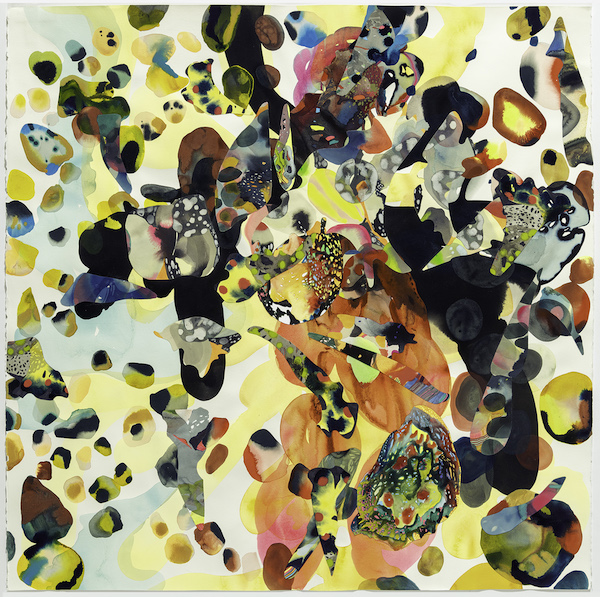The collage-paintings of Anne Austin Pearce are unabashedly beautiful. Born, raised and educated in Lawrence, Kansas, Pearce was associate professor of art at Missouri’s Rockhurst University until this year, when she assumed an associate professorship of studio art at Soka University, in Aliso Viejo. From her base in Orange County, she generates complex and hue-drenched phantasmagoria that are the culmination of her 34-year-long career in the arts. Beginning in June, Pearce began to display these works in her exuberant show, “Path,” which is now visible online at the Sherry Leedy gallery in Kansas City.

Anne Austin Pearce, Path: Hanged Shafts of Light, 2020
In many of “Path’s” ink-and-acrylic works on paper, Pearce stains and tints paper cut-outs and then assembles them into layered composites that resemble floral and faunal artifacts. Pearce claims an influence from Julie Mehretu, among others, and Mehretu’s whirligigging atmospheres do come to mind as one examines, say, Black, Wet, Stones (2020), a primarily black-and-yellow explosion of kinetic fronds and polka dots that resembles both a panther running through the forest and a galaxy being born. Pearce allows that she hit upon her collage practice when she began to use discarded acrylics as raw materials for fresh paintings: “I’d cut apart older works and collage the pieces into new work as a means to both understand and respond to hyper-felt feelings,” she says. “A small part of one painting becomes a mark within a bigger painting, worlds inside worlds.” This description of her method evokes yet other female artists, such as the great Lee Krasner, who began to furiously shred apart her drawings and remake them into collages after Jackson Pollock died.

Anne Austin Pearce, Path: Well Worth Waiting, 2020
Pearce’s catharsis strikes the viewer in Well Worth Waiting (2020), which has a huge tulip, or heart, or mitochondria flourishing at its center. Tie-dyed eggs or snake-heads crawl up the pink ascent as if it were a mountain, and then spume fuzzy peanuts, scraps of flannel shirts, and gold-dusted black holes. Similarly, in Honeyed Beach (2020), a cosmos of glittering kelp and jellyfish morphs into pieces of sky and patches of ancient maps; the viewer is mesmerized as she tries to trace a familiar shape – is this ocher blob a guinea pig, or a sunspot? – until she realizes that Pearce has merged earth’s elements in an ecstatic union.Pearce’s passions seem ecological, such as in First Plunged in Firefly (2020), where spotted clouds fuse with brightly striped tentacles, and a cerulean, oceanic swell pivots into a grassy savannah – or is it a mysterious calligraphy? Hers is an ambition to see relations between earth and sky, animal and human, which recalls also the reveries of Agnes Martin. For those feeling confused and sad right now, Path does not, at first, seem to offer political commentary, or observations of our current traumas and spirals. Yet, within the intensity of her colors and their combinations, Pearce does demand recognition of the essential, though sometimes invisible, connections between nature and its wary inhabitants.

Anne Austin Pearce, Path: Fist Plunged in Firefly, 2020
Anne Austin Pearce, Path, at Sherry Leedy Contemporary Art, Kansas City, Missouri
June 4-August 22, 2020, and online at https://sherryleedy.com/main/artists/anne-austin-pearce/


